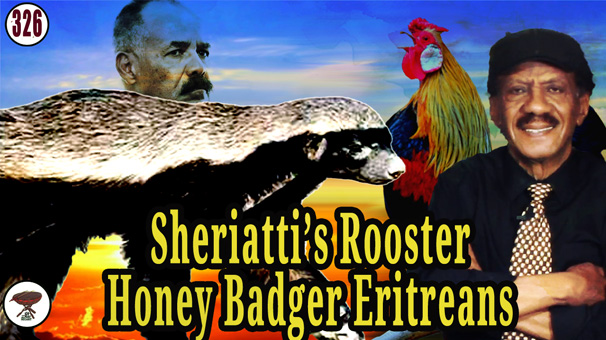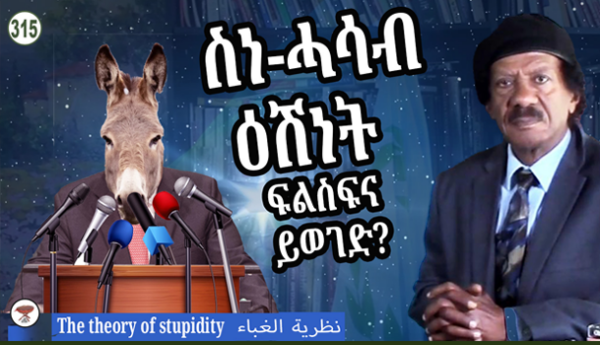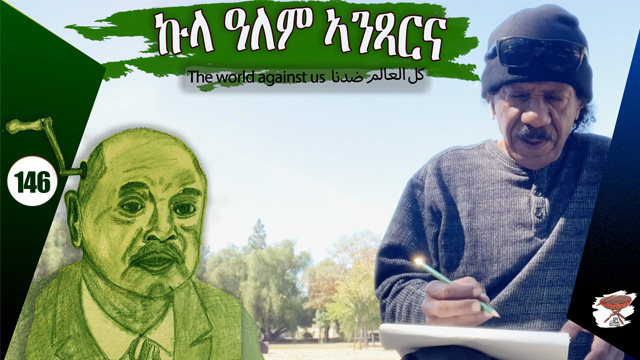Shariati’s Rooster; Honey budger Eritreans (Seramat)

Ali Shariati (Nov 1933 – June 1977) was an Iranian thinker and poet. He was 44 years old when he was found dead in England. British authorities said it was a heart attack, but many believe he was assassinated by the brutal Iranian security service, SAVAK. That was during the reign of Shah Mohammad Reza Pahlavi.
The late Ali Shariati once told a story:
I asked my neighbor why their rooster was no longer crowing.
He replied, “The neighbors complained it woke them up too early in the morning. So, we killed it and ate it.”
Ali Shariati concludes:
That day, I understood that if someone awakens people from their sleep, at least one of them will want to cut off his head.
People remember the chicken, but rarely the rooster. They remember what fills their stomachs, but not what awakens their minds.
Beware—don’t be a rooster.
That is Ali Sharieti’s story; his tormentor, the Shah didn’t have an enviable end
In 1979, the Shah was overthrown by Ayatollah Khomeini. Many countries refused to host the Shah, until Egypt under Anwar Sadat accepted him. He died in exile and was buried in Egypt.
I always remember the saying:
Fool me once, shame on you. Fool me twice, shame on me.
What a charming friendship! Each receives a rose—but who gets it first is just as important as the rose itself. Is it truly a rose, or just a flower? White flowers are often left on graves… but never mind. In some Eritrean cultures, we simply stick a sisal leaf into the ground, add a little water, and it grows. But a white flower? I’m not sure; we just plant a sisal leaf and move on.
Eritreans are honey badgers!
Eritreans, for the most part, resemble the honey badger. Eritreans are Seramat, and I’ll explain that shortly—be patient.
Why do cliques survive despite miserable governance, poverty, injustice, and indignity? Ask yourself and answer it honestly before trying to convince those who don’t agree with you.
Martin Luther King Jr.
Martin Luther King Jr. once said:
“History will have to record that the greatest tragedy of this period of social transition was not the strident clamor of the bad people, but the appalling silence of the good people.”
Now that you’ve made it this far, let me tell you why Eritreans are honey badgers (Seramat), and consider it a learning opportunity.
A Tigrayit proverb says, “Shafig Ewour welid” — “the hasty begets a blind child.” It means if you are in a rush, you miss the mark—even in creating a baby.
If you’re prone to hasty judgment and anger, anything can trigger you. Some may already be angry because I said Eritreans are Seramat. If you lack patience, your blood may boil over nothing.
So, what does Seram mean?
SERAM
First, I must thank my “walking dictionary”—my good friend Yerhwo Amlakh; his knowledge of Tigrinya words and cultural nuances is impressive. I usually skip the dictionary and consult him.
He told me that the honey badger is called Seram in Tigrinya. In Amharic, I believe it belongs to the same family as Tirrign.
Hunters collect Tirrign, cut off their testicles, and extract a secretion for use in the perfume industry as a fixative—to make scents last longer. Like skunks, honey badgers emit a strong smell to repel enemies. Ironically, that offensive smell becomes a prized element in high-end perfumes.
Nowadays, the industry has developed synthetic alternatives for ethical reasons. The Tirrign secretion business has all but died—it’s cruel and unethical.
I just wanted to offer this insight and a reminder that even nasty things can have value. It’s wise to avoid rigid thinking and broaden our perspectives. If you didn’t know—now you know what’s in your perfumes.
Yes, the Eritrean people are Honey badgers. Seramat inna! But before being enraged—it’s not an insult. Though many, including myself, thought Seram meant faultfinder, troublemaker, litigious, or “argumentative”—thanks to Yerhwo Amlakh, I and you now know that Seram means honey badger.
And to avoid confusion, Honey Badger is also the name of a shotgun developed by Kevin Brittingham and his R&D team for U.S. special forces—it mimics the AK-47.
During the era of the Eritrean liberation struggle, the AK-47 (Akhmes Hadeed) was the preferred weapon—whether the Czech, Chinese, or Russian variants. That’s trivia for casual conversation.
But let’s get back to…
The Honey Badger
The honey badger is fierce, resilient, daring, and brave. It measures between 1 and 3 meters, with mostly black fur and some white patches and stripes. It’s found across sub-Saharan Africa, the Middle East, and parts of Asia.
Honey badgers prey on smaller animals like frogs, but they fearlessly confront lions and tigers many times their size.
Now, do you agree Eritreans are like Seram? Are they not brave warriors—sometimes recklessly so?
The Seram reminds me of the late Omar, a fearless boy from my childhood who stood up to the brutal Tor Serrawit soldiers without blinking. Check Negarit 56 for more about Omar.)
Forget lions, leopards, and other praising symbols. Eritreans, for the most part, are like Seram. But let’s also be honest—we have our share of chickens and rabbits, too.
I would love to know how many of the readers (and viewers) knew the real meaning of Seram, the honey badger.
My next letter to the Eritrean people will be titled Yedres nabtom Serramat Eritrawyan.
Context Matters
Let me be clear: everything I said here is within the context of the topic. It’s not meant to inflate egos or give more fuel to arrogance; we already have more than enough of that—and it’s part of what ails our nation.
Also remember the flip side: we have far too many timid puppies. People who silently accept abuse and oppression, mistaking it for integrity and perseverance. That’s not virtue—it’s timidity.
 Regional News
Regional News



Shariati’s Rooster; Honey budger Eritreans (Seramat)
Ali Shariati (Nov 1933 – June 1977) was an Iranian thinker and poet. He was 44 years old when he was found dead in England. British authorities said it was a heart attack, but many believe he was assassinated by the brutal Iranian security service, SAVAK. That was during the reign of Shah Mohammad Reza Pahlavi.
The late Ali Shariati once told a story:
I asked my neighbor why their rooster was no longer crowing.
He replied, “The neighbors complained it woke them up too early in the morning. So, we killed it and ate it.”
Ali Shariati concludes:
That day, I understood that if someone awakens people from their sleep, at least one of them will want to cut off his head.
People remember the chicken, but rarely the rooster. They remember what fills their stomachs, but not what awakens their minds.
Beware—don’t be a rooster.
That is Ali Sharieti’s story; his tormentor, the Shah didn’t have an enviable end
In 1979, the Shah was overthrown by Ayatollah Khomeini. Many countries refused to host the Shah, until Egypt under Anwar Sadat accepted him. He died in exile and was buried in Egypt.
I always remember the saying:
Fool me once, shame on you. Fool me twice, shame on me.
What a charming friendship! Each receives a rose—but who gets it first is just as important as the rose itself. Is it truly a rose, or just a flower? White flowers are often left on graves… but never mind. In some Eritrean cultures, we simply stick a sisal leaf into the ground, add a little water, and it grows. But a white flower? I’m not sure; we just plant a sisal leaf and move on.
Eritreans are honey badgers!
Eritreans, for the most part, resemble the honey badger. Eritreans are Seramat, and I’ll explain that shortly—be patient.
Why do cliques survive despite miserable governance, poverty, injustice, and indignity? Ask yourself and answer it honestly before trying to convince those who don’t agree with you.
Martin Luther King Jr.
Martin Luther King Jr. once said:
“History will have to record that the greatest tragedy of this period of social transition was not the strident clamor of the bad people, but the appalling silence of the good people.”
Now that you’ve made it this far, let me tell you why Eritreans are honey badgers (Seramat), and consider it a learning opportunity.
A Tigrayit proverb says, “Shafig Ewour welid” — “the hasty begets a blind child.” It means if you are in a rush, you miss the mark—even in creating a baby.
If you’re prone to hasty judgment and anger, anything can trigger you. Some may already be angry because I said Eritreans are Seramat. If you lack patience, your blood may boil over nothing.
So, what does Seram mean?
SERAM
First, I must thank my “walking dictionary”—my good friend Yerhwo Amlakh; his knowledge of Tigrinya words and cultural nuances is impressive. I usually skip the dictionary and consult him.
He told me that the honey badger is called Seram in Tigrinya. In Amharic, I believe it belongs to the same family as Tirrign.
Hunters collect Tirrign, cut off their testicles, and extract a secretion for use in the perfume industry as a fixative—to make scents last longer. Like skunks, honey badgers emit a strong smell to repel enemies. Ironically, that offensive smell becomes a prized element in high-end perfumes.
Nowadays, the industry has developed synthetic alternatives for ethical reasons. The Tirrign secretion business has all but died—it’s cruel and unethical.
I just wanted to offer this insight and a reminder that even nasty things can have value. It’s wise to avoid rigid thinking and broaden our perspectives. If you didn’t know—now you know what’s in your perfumes.
Yes, the Eritrean people are Honey badgers. Seramat inna! But before being enraged—it’s not an insult. Though many, including myself, thought Seram meant faultfinder, troublemaker, litigious, or “argumentative”—thanks to Yerhwo Amlakh, I and you now know that Seram means honey badger.
And to avoid confusion, Honey Badger is also the name of a shotgun developed by Kevin Brittingham and his R&D team for U.S. special forces—it mimics the AK-47.
During the era of the Eritrean liberation struggle, the AK-47 (Akhmes Hadeed) was the preferred weapon—whether the Czech, Chinese, or Russian variants. That’s trivia for casual conversation.
But let’s get back to…
The Honey Badger
The honey badger is fierce, resilient, daring, and brave. It measures between 1 and 3 meters, with mostly black fur and some white patches and stripes. It’s found across sub-Saharan Africa, the Middle East, and parts of Asia.
Honey badgers prey on smaller animals like frogs, but they fearlessly confront lions and tigers many times their size.
Now, do you agree Eritreans are like Seram? Are they not brave warriors—sometimes recklessly so?
The Seram reminds me of the late Omar, a fearless boy from my childhood who stood up to the brutal Tor Serrawit soldiers without blinking. Check Negarit 56 for more about Omar.)
Forget lions, leopards, and other praising symbols. Eritreans, for the most part, are like Seram. But let’s also be honest—we have our share of chickens and rabbits, too.
I would love to know how many of the readers (and viewers) knew the real meaning of Seram, the honey badger.
My next letter to the Eritrean people will be titled Yedres nabtom Serramat Eritrawyan.
Context Matters
Let me be clear: everything I said here is within the context of the topic. It’s not meant to inflate egos or give more fuel to arrogance; we already have more than enough of that—and it’s part of what ails our nation.
Also remember the flip side: we have far too many timid puppies. People who silently accept abuse and oppression, mistaking it for integrity and perseverance. That’s not virtue—it’s timidity.